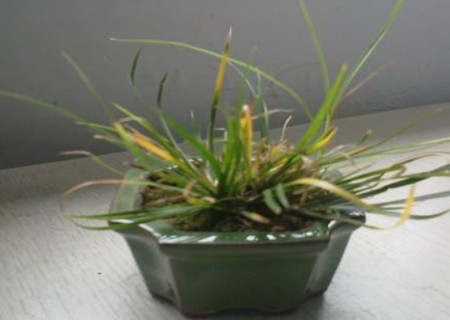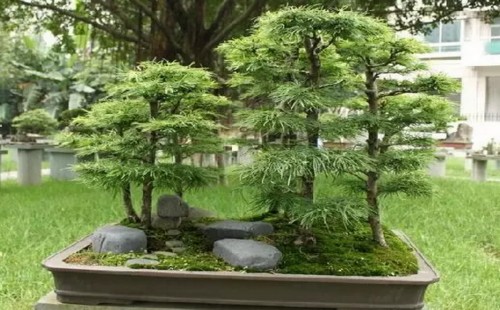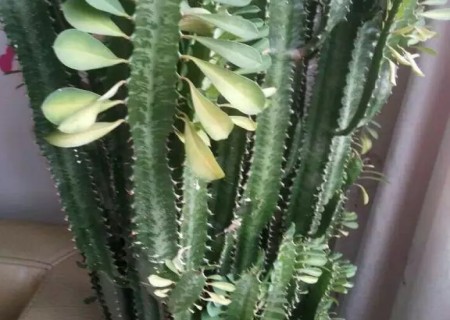What if the leaves of Acorus calamus are withered and yellow?
Calamus, seemingly a cluster of ordinary weeds, comes from the mountains, especially near the water source, but it is deeply favored by literati. However, calamus is a kind of plant with wind and bone, and its elegant posture shows extraordinary bearing. Put a potted calamus on the desk, green lingering fragrance, giving unlimited reverie.

As the saying goes,"painting bamboo is difficult to cap, raising Pu is difficult to green tip." Raising calamus is difficult to make the leaf tip green, otherwise it will affect its ornamental effect. So, what if the calamus leaves wither and turn yellow? Normally growing calamus is generally green all over the body. This situation is undoubtedly a problem in the maintenance process.
I. Yellow water
Calamus is more wet, and it usually doesn't hurt to pour more water occasionally, as long as the drainage effect of the bowl is good enough. However, if the basin drainage is not smooth or the substrate permeability effect is poor, the water in the basin will naturally affect the respiration of the plant root system, thus causing rotten roots. Therefore, over time, leaves will appear yellow, accompanied by withering phenomenon.
In view of this phenomenon, we need to control watering first, and put the calamus potted plant in a ventilated place to dry water to accelerate evaporation. If the matrix has poor water permeability, it needs to be replaced in time. As long as these two aspects of treatment, I believe that calamus will soon return to normal growth state.
II. Yellow drought
The above small editor said that because of the accumulation of water in the basin caused by the phenomenon of yellow and withered calamus, in fact, if the calamus long-term water shortage, will also appear similar phenomenon, but the yellow color is drought-yellow, will also affect the viewing effect. As we all know, calamus likes humidity but not drought tolerance, especially in high temperature weather, we should take timely hydration measures.
When calamus appears drought yellow and accompanying withered phenomenon, we should water it in time, but one time watering can not be excessive. Because long-term drought in the state of calamus, suddenly encountered heavy irrigation will be difficult to adapt, but also cause problems, so it needs to adapt to gradually increase watering. Watering during this period is a gradual process, and it is forbidden to rush for success and irrigate to the end.
III. Dry yellow
Dry yellow and the former two phenomena are not the same, or there is a big difference. The dry and yellow color of acorus calamus was mainly caused by low air humidity in its growth space, especially in air-conditioned rooms in summer or heated rooms in winter. Once the air humidity is too low, if it is not improved in time, the calamus is prone to dry yellow phenomenon, and it will wither when it is serious.
In view of the phenomenon of dry and yellow acorus, it is necessary to increase watering first, and at the same time, artificially create a high humidity environment to improve air humidity. In addition, if it is summer, the necessary shade measures should also be taken, or it can be directly moved to a cool and ventilated place for management.
IV. Burning yellow
Acorus calamus not only likes humidity, but also likes shade, so it has certain shade tolerance ability. During the maintenance and management period, it is only necessary to place it in a place where it can receive scattered light. On sunny days in winter, due to the mild sunshine, it can be directly exposed to light. If the light is too strong and no shade measures can be taken for it in time, the calamus is prone to burn yellow color, which seriously affects the viewing effect.
Burning yellow is mostly caused by too strong direct light. Since calamus likes shade environment, it only needs to be properly shaded, especially in the case of strong light, we need to take shade measures. It is recommended to put it in shade to let it receive scattered light.
V. Alkaline yellow
Acorus calamus likes to grow in acidic growth environment. When both substrate and water quality are alkaline, or there is too much accumulation of saline-alkali components in the pot without changing pots for a long time, its stems and leaves are easy to change from green to yellow, thus appearing alkaline yellow, which will also reduce the ornamental value of Acorus calamus bonsai.
To solve this situation, we need to look at the degree of alkali yellow to decide. If the alkalinity in the basin is not strong enough, and the calamus only slightly appears alkali yellow, then we can use ferrous sulfate diluent to synthesize it to reduce the alkalinity and keep the basin slightly acidic; if the alkali yellow degree is too deep, then it is recommended that we directly change the basin and change the soil!
VI. Frozen yellow
The most suitable growth temperature of calamus is between 15-25°C. When the temperature is as low as 10°C, its growth becomes very slow; if the temperature drops to 5°C, it is easy to be frostbitten if it is slightly careless, so that the stems and leaves appear yellowing phenomenon. This yellowing is usually defined as freezing yellow, and when it is serious, the plant will become withered.
When acorus appears frozen yellow, we should immediately put it into a warmer place for maintenance, hoping that its roots and stems can quickly regenerate. However, the temperature difference before and after should not be too large, otherwise it is easy to cause new growth problems. It is suggested that when keeping warm, the temperature should be gradually increased, which is mainly to make calamus gradually adapt to the process of warming up.
In general, acorus leaves yellow, or even withered phenomenon, we must first find its incentives, mainly in the above aspects. Once the cause is found, it should be timely prescribed medicine, in order to change the leaves of calamus from yellow to green as soon as possible. And the causes of yellow calamus leaves are not only the same, so we must take it seriously and investigate it carefully in order to solve this problem perfectly.
Time: 2019-05-30 Click:
- Prev

How can a potted plant not change soil?
Bonsai should not only be made well, but also do a good job in the maintenance and management of the later stage. Traditionally, potted plants need to be replaced after 2-3 or 4-5 years of cultivation, because the potted soil will harden to varying degrees after a long period of cultivation, affecting the irrigation and absorption of water and fertilizer.
- Next

What is the matter with yellow leaves?
Dragon bone flower is a common flower plant, but familiar pot friends love and hate it. Love is mainly love it domineering and unique, hate is mainly hate it covered with thorns, the body also contains toxins. However, as a pot friend who likes to plant it in potted plants, love is naturally better than hate. The keel flower also has a great advantage.
Related
- Fuxing push coffee new agricultural production and marketing class: lack of small-scale processing plants
- Jujube rice field leisure farm deep ploughing Yilan for five years to create a space for organic food and play
- Nongyu Farm-A trial of organic papaya for brave women with advanced technology
- Four points for attention in the prevention and control of diseases and insect pests of edible fungi
- How to add nutrient solution to Edible Fungi
- Is there any good way to control edible fungus mites?
- Open Inoculation Technology of Edible Fungi
- Is there any clever way to use fertilizer for edible fungus in winter?
- What agents are used to kill the pathogens of edible fungi in the mushroom shed?
- Rapid drying of Edible Fungi

